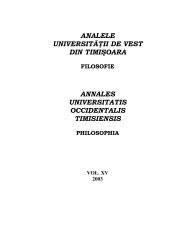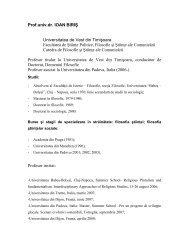VOL. IV (XXI) 2009 - Departamentul de Filosofie si Stiinte ale ...
VOL. IV (XXI) 2009 - Departamentul de Filosofie si Stiinte ale ...
VOL. IV (XXI) 2009 - Departamentul de Filosofie si Stiinte ale ...
You also want an ePaper? Increase the reach of your titles
YUMPU automatically turns print PDFs into web optimized ePapers that Google loves.
OANA BARBU 83<br />
We therefore believe that the recurrent use of metaphor in adverti<strong>si</strong>ng<br />
communication doesn't anymore serve the purpose of generating the<br />
surprise of the consumer public but responds to an existential need for the<br />
alternance of realities, for hyper-realities. Furthermore, as we will try to<br />
argue, it is mainly due to this double metaphorization of the adverti<strong>si</strong>ng<br />
discourse that it can be un<strong>de</strong>rstood by such diverse masses, managing to<br />
bridge socio-cultural gaps.<br />
By integrating metaphor in his communication, the individual is aware<br />
of the violation of linguistic conventions. If the use of words generally serves<br />
the purpose of interaction, transmitting meaning and receiving feedback, this<br />
is achieved through transmitting one of the meanings attributed by the<br />
dictionary. But a metaphor bypasses this convention by suggesting a hyperreality<br />
in which the meanings are inverted. Therefore, the individual is aware<br />
of the contravention with the linguistic conventions. Take for example this<br />
slogan for the Johnson & Johnson band aids, "Say hello to your child's new<br />
bodyguards", accompanied by a picture of band aids <strong>de</strong>corated with cartoon<br />
characters. The violation con<strong>si</strong>sts in this case in a neutral <strong>de</strong>viation of<br />
meaning, culminating with changing the meaning of the word bodyguard.<br />
Starting with the research of George Lakoff, contemporary cognitive<br />
linguistic theory con<strong>si</strong><strong>de</strong>rs metaphor as "omnipresent in day to day life",<br />
arguing that "our ordinary conceptual system [...] is fundamentally<br />
metaphorical in its nature" 2 . Consequently, literary-stylistic metaphors are<br />
only a subset of the metaphors used in day to day speech, a stylistically<br />
special case of literary works rooted though in the omnipresent metaphors of<br />
everyday’s life. Lakoff con<strong>si</strong><strong>de</strong>rs that these metaphors can be clas<strong>si</strong>fied into<br />
categories such as structural metaphors, orientational metaphors and<br />
ontological metaphors. The examples used by the author highlight the way in<br />
which a metaphor like "ARGUMENT IS WAR" can trigger a real<br />
"bombardment" on the vocabulary of those who interact.<br />
ARGUMENT IS WAR<br />
Your claims are in<strong>de</strong>fen<strong>si</strong>ble.<br />
He attacked every weak point in my argument.<br />
His criticisms were right on target.<br />
I <strong>de</strong>molished his argument.<br />
I’ve never won an argument with him.<br />
You disagree? Okay, shoot! If you use that strategy, he’ll wipe you out.<br />
He shot down all of my arguments 3<br />
Examples of structural metaphors like "argument is war", "love is a<br />
journey", and the famous "religion is opium for the masses", are instances of<br />
day to day speech illustrating the fact that we don't just talk about certain<br />
topics in a metaphorical way but we play the part <strong>de</strong>fined by the metaphor,<br />
creating an entire discourse according to its stage direction; we don't just talk<br />
2<br />
George Lakoff, M. Johnson , Metaphors we Live by, ed. Chicago Univer<strong>si</strong>ty Press,<br />
2003, p. 39<br />
3<br />
Ibid., p. 104




